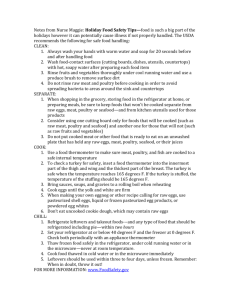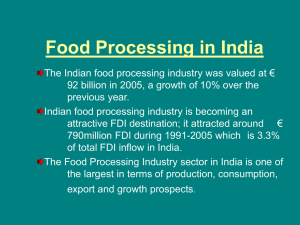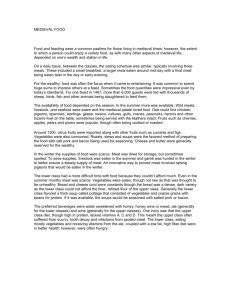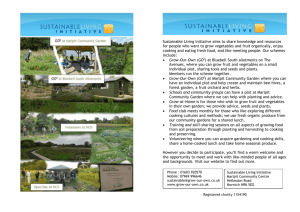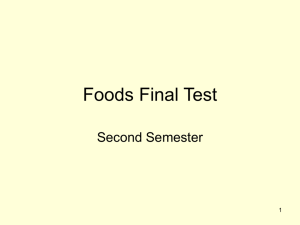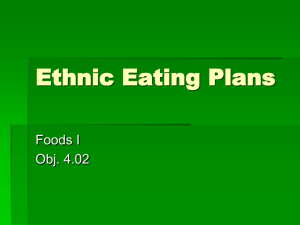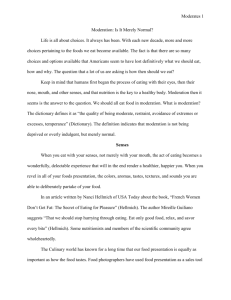Study Guide 2,05
advertisement
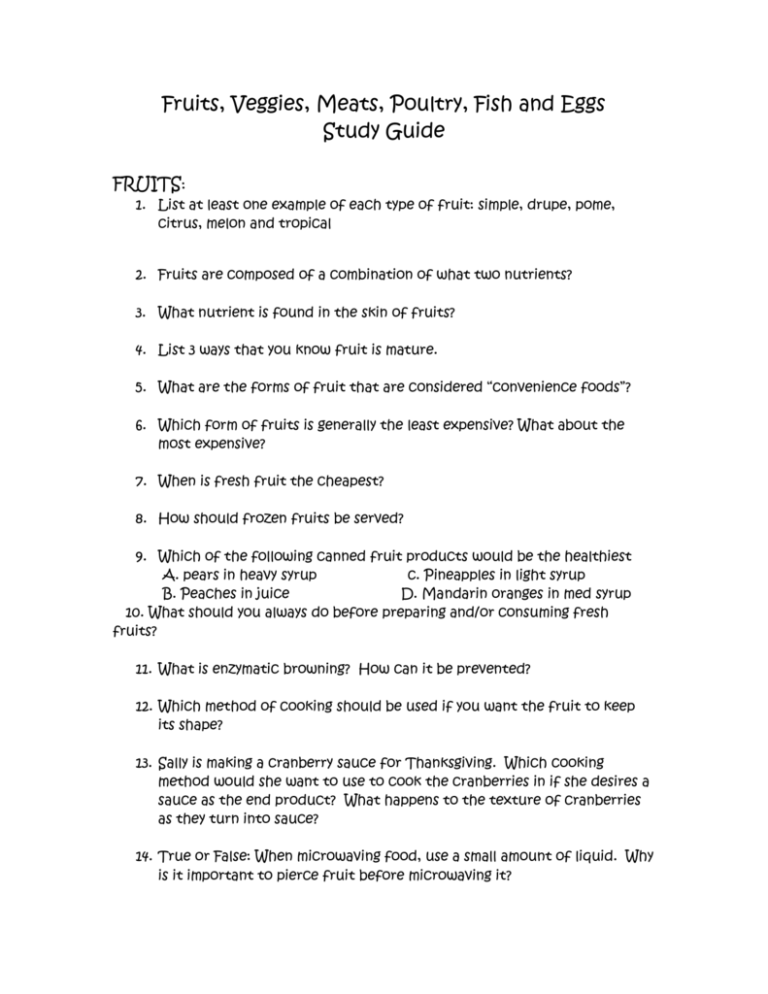
Fruits, Veggies, Meats, Poultry, Fish and Eggs Study Guide FRUITS: 1. List at least one example of each type of fruit: simple, drupe, pome, citrus, melon and tropical 2. Fruits are composed of a combination of what two nutrients? 3. What nutrient is found in the skin of fruits? 4. List 3 ways that you know fruit is mature. 5. What are the forms of fruit that are considered “convenience foods”? 6. Which form of fruits is generally the least expensive? What about the most expensive? 7. When is fresh fruit the cheapest? 8. How should frozen fruits be served? 9. Which of the following canned fruit products would be the healthiest A. pears in heavy syrup c. Pineapples in light syrup B. Peaches in juice D. Mandarin oranges in med syrup 10. What should you always do before preparing and/or consuming fresh fruits? 11. What is enzymatic browning? How can it be prevented? 12. Which method of cooking should be used if you want the fruit to keep its shape? 13. Sally is making a cranberry sauce for Thanksgiving. Which cooking method would she want to use to cook the cranberries in if she desires a sauce as the end product? What happens to the texture of cranberries as they turn into sauce? 14. True or False: When microwaving food, use a small amount of liquid. Why is it important to pierce fruit before microwaving it? 15. When baking fruit, what kind of fruits should you select? Which would turn out better in a baked recipe, an apple or a banana? 16. Define what it means to “poach” a food. 17. How long can fruits be stored in the refrigerator for? 18. How does refrigerating fruits affect them? VEGGIES: 19. Why is it important to wash vegetables before you eat them? 20. How should vegetables be washed? 21. Which vitamin is associated with eyesight? 22. Which nutrient can reduce heart disease and the risk of cancers? 23. True or False. Vegetables offer complete proteins. 24. Why do potatoes stored in the fridge taste different than one stored at room temp? 25. If microwaving veggies, how should they be arranged in the microwave? What size pieces should they be cut in? 26. Which is the healthiest way to cook vegetables? 27. How should cut veggies be stored? 28. List two examples of a tuber. 29. Describe the texture of a properly cooked vegetable. 30. List and describe 3 ways that overcooking can affect vegetables. 31. Before you store vegetables, why is it so important to make sure they are completely dried off? 32. What is enzymatic browning? How can it be prevented? Meats, Poultry and Fish: 33. What ground meat has the least amount of fat per serving? 34. List (3) examples of meat. 35. What (3) things factor in and make up a serving of meat? 36. The shoulder of meat is generally tough or tender? 37. Where should meat be stored? 38. Describe what marbling is. 39. What should red meat look like before being cooked? How do you know if it has gone bad? 40. Why is pork generally considered a tender meat? 41. List two ways to tenderize meat. Which of these works to break down elastin in the meat? 42. How do you know when a meat, poultry or fish product is done cooking? 43. List (3) examples of poultry. 44. What is an advantage of roasting poultry in a cooking bag? 45. How should you store fresh chicken? What about frozen? How should frozen chicken be thawed? 46. List some characteristics of spoiled fish. 47. List 3 examples of crustaceans. 48. Fresh fish & shellfish should be used within how many days? What about clams and oysters? 49. Should fish be cooked at a high temperature or a low temperature? EGGS: 50. What part of the egg has the majority of fat, calories and cholesterol? 51. What might be a way to lower the cholesterol when using eggs? 52. What does cream of tartar have to do with eggs? 53. How long can eggs be stored in the refrigerator? 54. List three ways that eggs can be cooked. 55. Egg whites are used make this type of topping. 56. List and describe 3 uses of eggs in cooking a. b. c. 57. What is a legume? 57. How many legumes are equal to a serving of meat? 58. Explain how dried beans should be prepared prior cooking. 59. Dried beans, nuts and seeds are part of what food group? Dairy: 60. Do dairy products offer complete or incomplete protein? Saturated or unsaturated fat? 61. What would be a good low-fat alternative to using mayo or sour cream in a recipe? 62. How many grams of fat should a product contain to be labeled Low Fat? 63. Which type of milk is best for you? 64. What is the difference between skim and whole milk? 65. Describe the following terms: Scorching, Curdling, Scum/Skin. 66. Why should dairy be stored away from light? 67. List 3 examples of what one serving of cheese would be. 68. Define the following terms: Pasteurization and Homogenization 69. What are some characteristics of processed cheese? 70. Give an example of hard cheese and a soft cheese. Other questions: 1. How is bacon broiled? 2. How do you braise a beef steak 3. What takes the longest time to prepare? Cheese biscuit, Omelet, Three bean casserole, tossed salad 4. Buttermilk is an example of what type of milk product? 5. What type of heat is used to cook meat? 6. What cook method should be used on a tough cut of meat? 7. What are legumes? 8. Primary benefit of legume? 9. How should fruit be eaten to best preserve nutrients?


